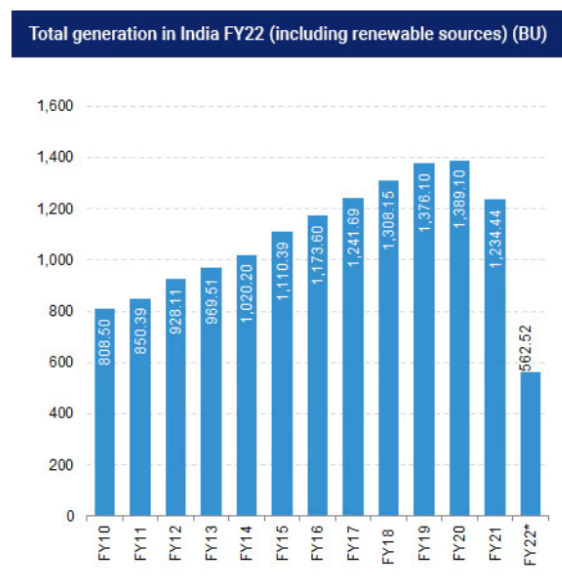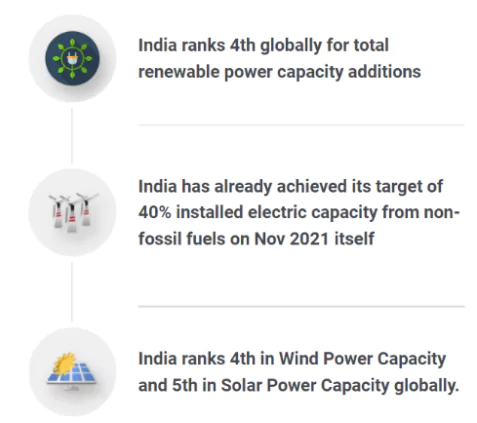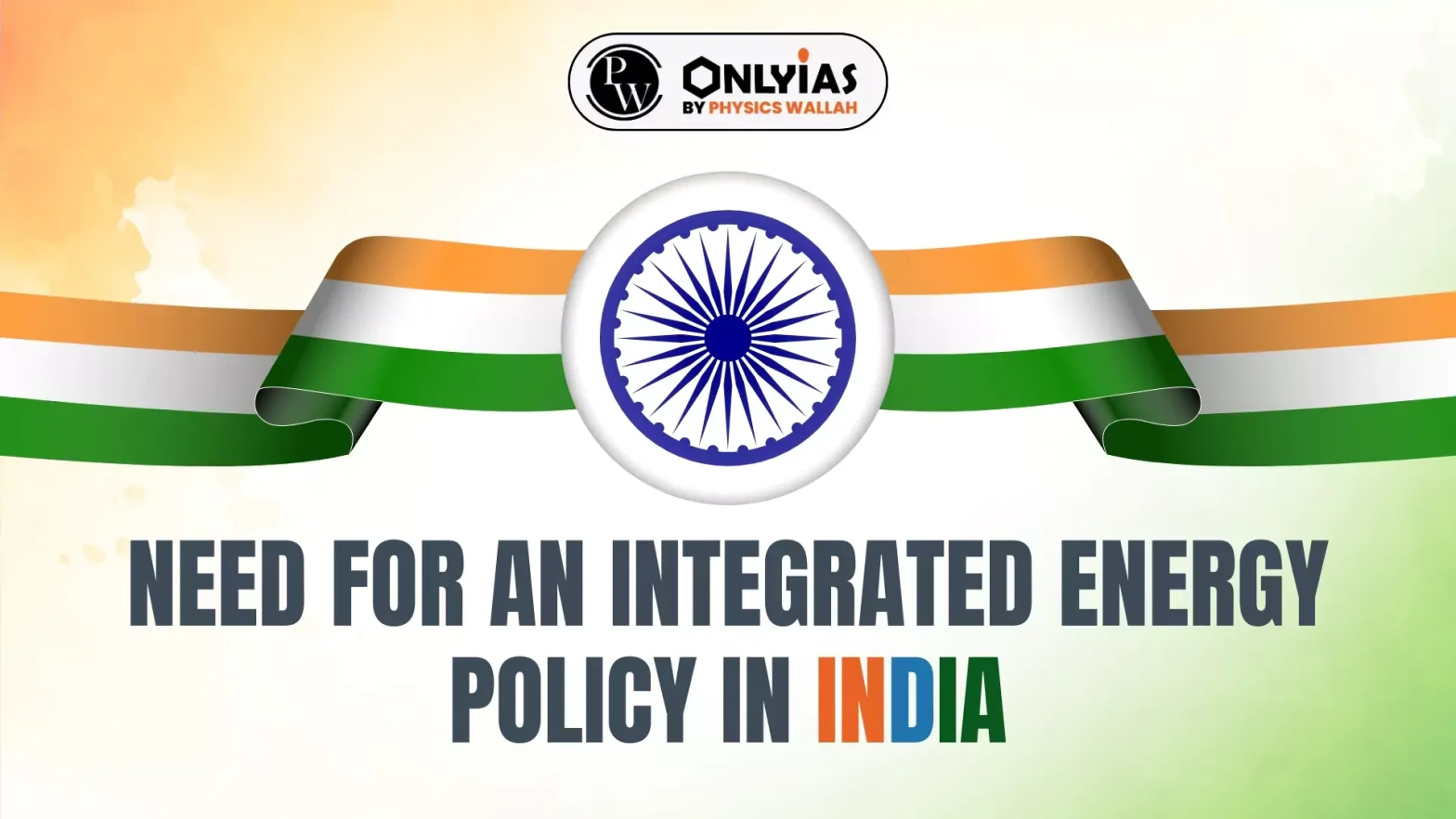The recent power shortages, due in part to unbalanced growth in renewable energy capacity over the past decade, demonstrate the need for better resource planning at both central and state levels.
- To improve supply adequacy, diversity metrics can be used while formulating policies.
About India’s Power and Energy Sector

Power and Energy are two essential inputs for economic development and improving the quality of life in India.
- Various Components: India’s power sector is one of the most diversified in the world. Sources of power generation range from conventional sources such as coal, lignite, natural gas, oil to viable non-conventional sources such as wind, solar, agricultural, and domestic waste.
- India is the only country among the G20 nations that is on track to achieve the targets under the Paris Agreement.
- Statistics: India’s power generation witnessed its highest growth rate in over 30 years in FY23. According to data from the Ministry of Power, India’s power consumption stood at 1,503.65 BU in April 2023.
- Observed Increase: Power generation in India increased by 6.80% to 1,452.43 billion kilowatt-hours (kWh) as of January 2024.
 Installed Capacity: India is the third-largest producer and consumer of electricity worldwide, with an installed power capacity of 429.96 GW as of January 2024.
Installed Capacity: India is the third-largest producer and consumer of electricity worldwide, with an installed power capacity of 429.96 GW as of January 2024.- Contribution by Various Sources: India’s installed renewable energy capacity (including hydro) stood at 182.05 GW, representing 42.3% of the overall installed power capacity.
- As of 2021, India was ranked fourth in wind power capacity and solar power capacity and fourth in renewable power installed capacity.
- As of April 2024, Solar energy contributed 82.63 GW, followed by 46.16 GW from wind power, 10.35 GW from biomass, 5.00 GW from small hydropower, 0.59 from waste to energy, and 46.93 GW from hydropower.
- Dependence on Conventional Sources: India has heavy reliance on coal and oil, which account for 53% and 20% of commercial primary energy consumption respectively.
- Thermal power plant load is estimated to improve by 63% in FY24, fuelled by strong demand growth along with subdued capacity addition in the sector.
Enroll now for UPSC Online Course
Rise in Demand of Power and Energy in India
Electricity demand in the country has increased rapidly and is expected to rise further in the years to come. In order to meet the increasing demand for electricity in the country, massive addition to the installed generating capacity is required.
- High Power Consumption: Growing population along with increasing electrification and per-capita usage will provide further impetus.
- Power consumption in India in FY23 logged a 9.5% growth to 1,503.65 billion units (BU).
- Data by the Central Electricity Authority (CEA): CEA estimates India’s power requirement to grow to reach 817 GW by 2030.
- Also, by 2029-30, CEA estimates that the share of renewable energy generation would increase from 18% to 44%, while that of thermal energy is expected to reduce from 78% to 52%.
India’s Initiatives and Actions for Power and Energy Sector
Over the last decade, India’s energy sector has carefully navigated the challenges of climate change and contentious issues of political economy without losing sight of the need to meet the energy demand required to become an industrialised country by 2047.
- Attractive Opportunities: In the Budget for 2024, the government’s power sector initiatives have been allocated funds that are 50% higher.
-
- Increased funds have been allocated to green hydrogen, solar power, and green-energy corridors.
- Thermal Units: To meet India’s 500 GW renewable energy target and tackle the annual issue of coal demand-supply mismatch, the Ministry of Power has identified 81 thermal units which will replace coal with renewable energy generation by 2026.
- Recently, the Indian government officially asked to become a member of the International Energy Agency (IEA).
- Policy Support: Various Schemes: Deen Dayal Upadhyay Gram Jyoti Yojana (DDUGJY) and Integrated Power Development Scheme (IPDS) are expected to augment electrification across the country.
- PM-Surya Ghar-Muft Bijli Yojana: For installing rooftop solar in One Crore households.
- National Green Hydrogen Mission: Aims to accelerate the deployment of Green Hydrogen as a clean energy source, will support the development of supply chains that can efficiently transport and distribute hydrogen.
- Wind-Solar Hybrid Policy: In 2018, national policy was announced to promote an extensive grid-connected wind-solar PV hybrid system for efficiently utilising transmission infrastructure and land.
- Atma-Nirbhar Bharat: PLI scheme in Solar PV manufacturing with financial outlays of INR 24,000 Cr introduced under Atma-Nirbhar Bharat.
- Rent a Roof Policy: The Government of India is preparing for this policy to support its target of generating 40 GW of power through solar rooftop projects by 2022.
- It also plans to set up 21 new nuclear power reactors with a total installed capacity of 15,700 MW by 2031.
- Other Major Government Initiatives: Pradhan Mantri Sahaj Bijli Har Ghar Yojana (SAUBHAGYA), Green Energy Corridor, National Smart Grid Mission and Smart Meter National Programme, Faster Adoption and Manufacturing of (Hybrid &) Electric Vehicles (FAME), International Solar Alliance, etc.
- The government plans to establish a renewable energy capacity of 500 GW by 2030.
- The government is committed to increasing the use of natural gas from the current primary energy levels of 7% to 15% by 2030.
- Higher Investments: As per the National Infrastructure Pipeline 2019-25, energy sector projects accounted for the highest share (24%) out of the total expected capital expenditure of Rs. 111 lakh crore (US$ 1.4 trillion).
- 100% FDI allowed in the Power Sector: It has boosted FDI inflow in this sector.
- Total FDI inflows in the power sector reached US$ 18.28 billion between April 2000-March 2024.
Challenges faced by the Indian Power and Energy Sector
In the current decade (2020-29), the Indian electricity sector is likely to witness a major transformation with respect to demand growth, energy mix and market operations.
- Limited Energy Resources: India has limited energy resources such as coal, oil, and gas, and it depends on imports to meet its growing energy demands.
- Import Data: Of the total volume recorded in March 2024, non-coking coal import stood at 15.33 MT, against 13.88 MT in March FY23, while coking coal import was 5.34 MT against 3.96 MT a year ago. During FY24, non-coking coal import was at 175.96 MT, higher than 162.46 MT imported during FY23.
- Also, India’s coal reserves are of low quality and there are significant environmental concerns associated with their extraction and use.
- Insufficient Power Generation: India’s installed capacity to produce power is insufficient to sustain a 7–8% annual economic growth. India’s commercial energy supply needs to develop at a rate of approximately seven percent in order to meet the rising demand for electricity. Currently, India can only add 20,000 MW per year.
- According to the International Energy Agency, India’s electricity demand is expected to triple by 2040. To meet this demand, the Indian government has set a target to increase the country’s installed power generation capacity to 450 GW by 2030.
- Unsatisfactory performance of State Electricity Boards (SEBs): SEBs, which distribute electricity, incur losses exceeding ₹20,000 crores due to operational inefficiencies, incorrect electricity pricing, and transmission and distribution losses.
- A major portion of these losses is due to power theft and free supply of power to farmers.
- Poor Infrastructure: India suffers from frequent power cuts and blackouts.
- Ageing power plants and transmission networks impede growth and transmission efficiency.
- The poor energy infrastructure is also affecting the development of the country’s rural areas, where many people do not have access to electricity.
- Climate change is also affecting India’s energy infrastructure, as extreme weather events such as floods and droughts are becoming more frequent and severe.
- Aggregate Technical & Commercial (AT&C) loss: It is an actual measure of performance of a power distribution system as it includes both technical losses and commercial losses. it shows the gap of input energy into the system and the units for which the payment is collected.
- Inadequate Investment: India’s energy sector requires significant investment to improve its infrastructure and expand its energy capacity. However, the government and private sector are not investing enough in the energy sector.
- India’s low per capita income and high poverty rates also make it difficult for people to afford clean energy sources.
- India’s pledge at the COP-26 summit to have 500 GW of non-fossil generation capacity by 2030. These will require investments of about Rs 32 lakh crore.
- Underutilization of Renewable Energy Potential: The National Electricity Plan (NEP) projects a compounded annual growth rate (CAGR) of 7% in energy demand from FY22 to FY27.
- To achieve sustainable growth, the revised energy mix places greater reliance on solar energy.
- The report estimates that the pace of solar installations will need to double to over 30 GW per year to meet the NEP targets.
- On Regulation: Electricity is listed in a ‘concurrent list’ in seven schedules, therefore there is lack of coordination and cooperation between centre and states.
- Others: Overloading of the transmission lines, Discoms continue to register financial losses, technical and commercial losses remain high, although private participation is permitted, their presence among discoms is limited.
Check Out UPSC CSE Books From PW Store
Challenges in Inclusive adoption of Renewable Energy in India
With the rising need for climate action, renewable energies need to be harnessed, from both ‘base load’ supply security as well as competitiveness perspectives.
- High Prices: The shift from coal for power generation (accounts for 75% generation, 50% carbon emission) lies in developing round-the-clock (RTC) alternate supplies at affordable prices.
- While solar tariffs are competitive, for the short to medium term, the complementary low-carbon capacities for RTC supplies are currently expensive (battery), or risk laden (hydel resources).
- Green Hydrogen is expensive too.
- Dependency on the Supply Security: To meet supply security with the rising demand is equally important.
- Example: Owing to water bodies going dry, Canada, which was dependent largely on its vast hydel resources, is now buying fossil fuel-fired electricity from across the border.
- Distribution: In the case of City Gas Distribution (CGD), a major hurdle lies at the municipal level, where the cost of access to lay pipelines is exorbitantly high due to municipal levies.
- Also, to improve the viability of gas over coal in the electricity sector, regulatory reforms are needed to determine the actual cost of electricity that consumers should pay.
- Others:
- EVs suffer from lack of adequate charging infrastructure.
- In the agriculture sector, nitrogen is the most consumed nutrient. However, a shift to a cleaner option, namely Green Ammonia, is expensive.
- In the case of cooking gas, piped natural gas is a cheaper option than the dominant supply of LPG (without subsidy) in the country.
Need for an Integrated Energy Policy
Implementing policies to reduce energy tariffs and subsidies, promote competition in the energy sector, and invest in energy-efficient technologies to lower overall costs is a need of the hour.
- Energy Security: Over 40% of India’s oil comes from the volatile Middle East. Geopolitical tensions and sanctions can disrupt supplies, impacting prices and economic stability.
- To Meet with Growing Demand: India’s energy demand is projected to surge by 1.8% annually until 2040. A comprehensive policy ensures sufficient and reliable energy supplies to fuel this growth.
- Domestic Potential: India has an immense potential for renewable energy sources like solar and wind. A well-integrated policy can unlock this potential, reducing dependence on imports and fostering energy independence.
- Environmental Sustainability: As India is the world’s third-largest emitter of greenhouse gases, an integrated policy that prioritises renewable energy and energy efficiency is significant to meet climate change commitments and ensure a sustainable future.
Way Forward
As a developing country on its journey to ‘Viksit Bharat’ by 2047, ‘Just’ transition is an important aspect of government policy that enables reasonable pricing and availability of mass consumption products.
- Need for a Differential Approach: India’s global engagement on carbon, especially at the United Nations-led COP conferences, has ensured that the principle of Common But Differentiated Responsibilities and Respective Capabilities (CBDR-RC) has prevailed.
- Low-emission strategies must provide for a differential approach to the energy mix through policy incentives in keeping with our social-economic obligations.
- Thus, policies must evolve to recognise the various aspects of technology and its ability to disrupt.
- Example: Repurposing coal to produce petrochemicals or the declining cost of scrubbing carbon from the air.
- Use of Incentives to promote the Adoption of Renewable Energy: The government should encourage the development of renewable energy projects through incentives and subsidies.
- Carbon pricing can help to incentivize the use of renewable energy by putting a price on carbon emissions.
- Develop smart grid technologies to integrate renewable energy sources effectively.
- Role of Institution: Institutions like NITI Aayog can seek to disseminate and synthesise information.
- This would cover the whole gamut of climate issues, e.g. balancing fossil fuels and clean fuels from a taxation perspective, pricing of mass consumption products, developing carbon markets, addressing ‘just transition’ requirements, etc.
- This will also facilitate the medium to long-term energy transition, where stakeholders are able to play their role smoothly in a synergistic way and with measurable results.
- Review of Existing Projects: To improve fuel diversity in an ‘organic’ manner, the risk models used by lenders to appraise projects are currently biased towards coal projects, and needs to be reviewed.
- Example: According to a study, in Europe, the loan loss-provisioning for low carbon sectors is twice that for big emitters.
- This approach will also facilitate faster adoption of newer technologies to reduce emissions in hard-to-abate sectors like cement and steel that use coal or the petrochemical sector which uses naphtha as a feedstock.
- Public-Private Partnership: There is a need to push for wider-scale implementation of public private partnership models. The private sector has been playing a key role in generating power, a more supportive environment will help in bridging the energy deficit of the country.
- Technological Innovation: To meet the growing demand for electricity, the Indian power industry must harness technological innovations.
- Use of Artificial intelligence (AI): AI is being used in the power industry to optimise energy production and distribution.
- AI algorithms can analyse large amounts of data to predict energy demand and optimise energy supply. AI is also being used to monitor and maintain power equipment, reducing maintenance costs and downtime.
- Use of Blockchain Technology: It is being explored in the power industry for its potential to improve energy trading and management.
- It can be used to enable peer-to-peer energy trading, allowing individuals and businesses to buy and sell energy directly without the need for intermediaries.
- It can also be used to track the source of energy and ensure its authenticity, improving transparency and trust in the energy market.
- Others: Incentivise exploration and production of domestic oil and gas reserves, invest in (R&D) of new extraction technologies, and promote energy efficiency to reduce reliance on imports.
- Invest in upgrading and expanding the energy infrastructure, including power grids, pipelines, and storage facilities.
Enroll now for UPSC Online Classes
Conclusion
India wants to ensure that everyone has reliable access to sufficient electricity at all times, while also accelerating the clean energy transition by lowering its reliance on fossil fuels and moving toward more environmentally friendly, renewable sources of energy.
- India’s energy basket requires a larger presence of renewable, gas, hydro and nuclear-based capacities. Currently, they stand at modest levels at 25% of the total generation.
![]() 17 Jul 2024
17 Jul 2024


 Installed Capacity: India is the third-largest producer and consumer of electricity worldwide, with an installed power capacity of 429.96 GW as of January 2024.
Installed Capacity: India is the third-largest producer and consumer of electricity worldwide, with an installed power capacity of 429.96 GW as of January 2024.